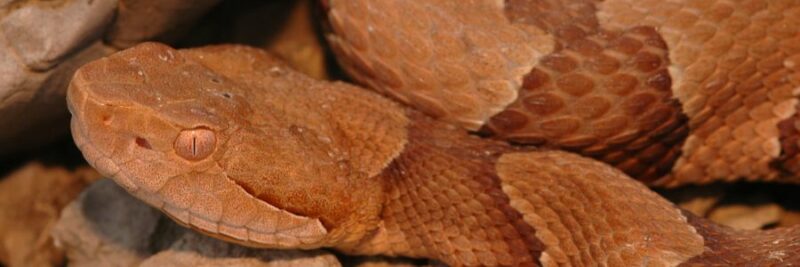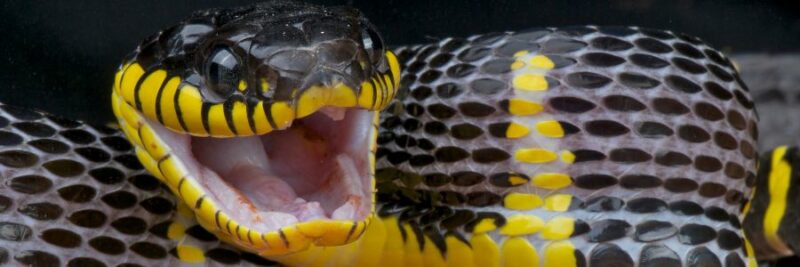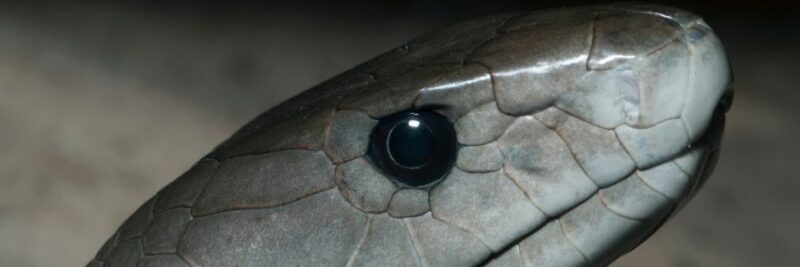Let's Talk About the Allure of Keeping Hot Herps

Now I know the idea of keeping venomous snakes is gonna make some folks uneasy – and believe me, I get it. These awe-inspiring animals demand healthy respect. But while the word “venomous” may conjure those panic-fueled images of unhinged serpents chasing people down, the reality is these fascinating creatures can actually make for rewarding captives when properly understood and cared for responsibly.
So if you find yourself intrigued by that iconic rattle or allured by the hypnotic sway of a king cobra, don’t tune out just yet. With the right prep and permissions, the advanced hobbyist can absolutely develop meaningful bonds with these special herps. Allow me to elaborate a bit before we dive into the how-to…
See, behind those piercing eyes and needle-sharp fangs lies an incredibly diverse array of epic animals, from heavy-bodied pit vipers to lithe African mambas to cryptically-patterned sea snakes and beyond. Get to know them, and you’ll discover intricate behaviors, problem-solving intelligence, and even personalities as individual as a pet cat or dog.
And while their business ends undoubtedly demand caution, proper tools and techniques empower keepers to safely interact without much drama. No one’s getting chased around the room – when respected, these animals pose little threat. And the educational rewards of keeping hot herps easily outweigh any negligible risks.
Just know it’s not something to take lightly. But approach venomous care with diligence under an experienced mentor, and you just may find a profoundly fulfilling new pastime.
Alright, let’s get into the nitty gritty of responsible hot herp ownership…
Securing Permits and Understanding Regulations

Before acquiring any venomous snake, priority one is making 100% sure you can legally own said animal in your area. Restrictions vary wildly depending on species, county, state, country, etc – so never assume it’s allowed without explicit permission.
In the United States, regulations fall under state jurisdiction. A select number fully prohibit hots, but most impose strict permitting processes for private ownership. Common requirements include proof of training, minimum age limits, hospital protocols, and heavily fortified caging inspected by officials. Some states also place caps on the number or species permissible, while many ban native hot snakes like rattlesnakes altogether.
Local statutes may pile on additional constraints too, so investigate thoroughly. Fines for lapsed documents or other violations can be severe.
And remember – poorly regulated expos and lax neighbors do not supersede the protocols put forth by your wildlife agency. Do your due diligence obtaining all necessary licenses.
Good Beginner Species for New but Committed Keepers
Alright, with the red tape addressed, what hot snakes represent realistic starters once fully permitted?
For all first timers, I strongly advise rear-fanged colubrids over vipers, elapids, or other advanced species. These mild-mannered yet exciting snakes offer tangible venom while allowing for relatively safe handling.

The Asian mangrove snake and copperheads are two especially suitable options. Despite ominous reputations, both tend towards flight over fight if given adequate enclosures. Neither species typically displays intense defensive behaviors that could endanger novice keepers.

Other rear-fanged Colubridae like false water cobras, vine snakes, and African twig snakes also merit consideration. Just know not all species in this family possess medically significant venom. Target those confirmed to provide an extra margin of respect without overwhelming toxicity.

I’ll emphasize once more though – Do not attempt intermediate vipers or front-fanged elapids without years of prior venomous snake experience. The margin for error with cobras, mambas, and rattlesnakes verges on nonexistent. Only seasoned experts willing to accept severe consequences should entertain these captives.
Constructing Safe and Secure Enclosures
Perhaps obvious but can’t overstate – safely housing venomous serpents demands impeccably fortified habitats cleared by permitting agents. These enclosures serve as your absolute last line of defense, critical for preventing any possibility of escape.

For vipers, arboreal snakes, and other far-ranging species, plan for enclosures no smaller than 4 feet long by 2 feet wide by 2 feet tall.
Construct cages from non-porous, rigid materials only – sealed wood or composite panels, plate glass, and heavily reinforced screen tops. All doors must include redundant locks and remain tightly clamped at all times. Expect officials to rigorously test latches and checkpoints during inspections.
Also critical are easily disinfected and impermeable substrate barriers against venomous fangs or waste. Sturdy plastic panels lining the lower 12-18 inches prevent oral contact with beddings while allowing burrows.
Finally, situate hot snake racks in dedicated venomous reptile rooms secured with double entry doors, locking outer-windows, and warning signage. Never house them in high-traffic areas of homes or facilities.
Smart Precautions for Care and Handling
Caring for and working with venomous snakes demands slow, deliberate maneuvering guided by sound judgment – no sudden movements or grabbing attempts as you might see on shock-value reality shows. Instead, keepers rely on specialized tools designed to safely direct serpents during maintenance tasks while minimizing stress.

Fortified serpent hooks offer secure control over a snake’s head to prevent bites, aided by prop sticks for handling mid-sections of the body. Clear acrylic restraint tubes allow cleaning and cage transfers by coaxing animals inside – thereby eliminating handling altogether.
Feeding frozen thawed prey items from long tongs or forceps eliminates strike risks surrounding live rodents. Venomoid snakes rendered permanently unable to produce venom also provide added safety assurances when necessary, but pose an ethical issue. Note though that venomoid surgeries remain highly controversial due to physiological burdens.
Just as critical is the anti-venom – ALWAYS maintain multiple doses on-site and an emergency protocol for getting bitten individuals to the hospital. Never keep hots without both.
And as tempting as free-handling may seem, NEVER manipulate venomous species outside tools and barriers without assuming immense personal liability. Things can go sideways in an instant, and no thrill merits such foolish risks.
An Investment Like No Other

Make no mistake – properly outfitting for venomous herps requires extensive investments of time, space, and money. Housing materials, freeze-dried rodents, equipment, medical preparations, feeder colonies, permits – expenses stack up quickly.
What’s more, most hots live 10 years or longer in captivity. This represents a lifelong commitment – not some short-lived pet project. Even experts occasionally tire of the unrelenting demands over time. Casual hobbyists almost certainly will.
So while the ambitious herp keeper willing to study under mentors and outfit properly can indeed find great reward and purpose in this profoundly focused pursuit – don’t undertake venomous care half-cocked. Spend time introspecting, speak with veterans about realities beyond the allure, and ask yourself honestly – am I POSITIVELY ready for such a serious obligation?
If any doubts linger, stick with legions of rewarding non-venomous species. But for the bold few prepared to embrace the journey in full, hot herps may prove the adventure of a lifetime.
Just promise you’ll put safety first and stay humble! Now let’s get into those frequently asked questions…
Frequently Asked Questions About Keeping Venomous Snakes as Pets
Laws for owning venomous snakes fall under state and sometimes local jurisdictions in America. Most states impose strict permitting processes, while some prohibit hots outright. Never acquire a hot snake without first securing all necessary licenses and paperwork from wildlife agencies in your area. Penalties for violations can be severe.
For beginners, rear-fanged colubrid snakes like mangroves and boomslangs make ideal first hot snakes, providing safety through mild venom and tentative dispositions. Avoid vipers, cobras, mambas and other front-fanged species until several years training under expert mentors.
Hands-off tools like hooks, tubes, and feeding devices enable safe manipulation, along with barriers. But free-handling should be avoided outside experts demonstrating in controlled settings. Always maintain anti-venom supplies and emergency protocols as well.
Success keeping hots requires extensive preparations - fortified cages and rooms, medical plans, plus huge investments of time and money. Never impulse buy. Instead spend time researching laws in your area, training under qualified mentors, preparing emergency protocols, and self-evaluating your motivations before acquiring venomous snakes. This represents a lifelong commitment not to be taken lightly.

Owning venomous snakes is not for the faint of heart – it’s a rewarding yet intense pursuit demanding acute attention to protocols and safety. But for那e select few willing to fully commit to proper procedures and hands-on education from veterans, hot herps can become cherished captives for a lifetime.
If you elect to travel down this road, take things slowly, follow the guidance here to start, and never stop learning. Kingdom Serpentes holds wonders beyond imagination for those brave enough to heed its dangers. I wish you profound journeys ahead with your future scaley companions! Please remember to always put safety first for yourself and these awe-inspiring animals.
